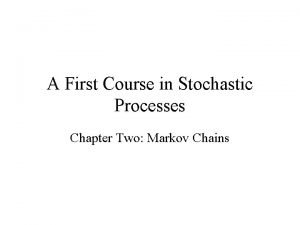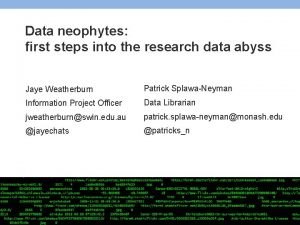First Steps With Deep Learning Course Deep learning
















- Slides: 16

First Steps With Deep Learning Course

Deep learning frameworks ▪ Modern tools make it easy to implement neural networks ▪ Often used components ▪ Linear, convolution, recurrent layers etc. ▪ Many frameworks available: Torch (2002), Theano (2011), Caffe (2014), Tensor. Flow (2015), Py. Torch (2016)

Pytorch ▪ Fast tensor computation (like numpy) with strong GPU support ▪ Deep learning research platform that provides maximum flexibility and speed ▪ Dynamic graphs and automatic differentiation

Developers

Outlines ▪ Basic concepts ▪ Write a model ▪ Classification of MNIST dataset

Basic Concepts torch. Tensor - similar to numpy. array autograd. Variable - wraps a Tensor and enables auto differentiation autograd. Function - operate on Variables, implements forward and backward nn. Parameter - contain Parameters and define functions on input Variables nn. Module - contain Parameters and define functions on input Variables

Basic Concepts

Basic Concepts import torch x = torch. rand(10, 5) y = torch. rand(10, 5) z=x*y

Basic Concepts import torch x = torch. rand(10, 5) y = torch. rand(10, 5) z=x*y import torch x = torch. ones(5, 5) b = x. numpy()

Basic Concepts import torch x = torch. rand(10, 5) y = torch. rand(10, 5) z=x*y import torch x = torch. ones(5, 5) b = x. numpy() import torch import numpy as np a = np. ones(5) x= torch. from_numpy(a)

Basic Concepts import torch x= torch. rand(100, 100) x = x. cuda()

Gradients ▪ Variables wrap a tensor and saves a history ▪ Used for automatic differentiation import torch from torch. autograd. variable import Variable x = Variable(torch. ones((2, 2)), requires_grad=True) y=x+2 z=y*y*3 out = z. mean() out. backward() print(x. grad)

Network definition class Two. Layer. Net(torch. nn. Module): def __init__(self, D_in, H, D_out): super(Two. Layer. Net, self). __init__() self. linear 1 = torch. nn. Linear(D_in, H) self. linear 2 = torch. nn. Linear(H, D_out) self. relu = torch. nn. Re. LU(inplace=True) def forward(self, x): h_relu = self. linear 1(x) h_relu = self. relu(h_relu) y_pred = self. linear 2(h_relu) return y_pred

Optimize the Network N, D_in, H, D_out = 64, 1000, 10 model = Two. Layer. Net(D_in, H, D_out) loss_fn = torch. nn. MSELoss(size_average=False) optimizer = torch. optim. SGD(model. parameters(), lr=1 e-4) for t in range(500): # Forward pass: Compute predicted y by passing x to the model y_pred = model(x) # Zero gradients, perform a backward pass, and update the weights. optimizer. zero_grad() loss. backward() optimizer. step()

Classifying Handwritten Digits Input Image Conv 5 x 5, 1/10 Max. Pool 2 x 2 + RELU Conv 5 x 5, 10/20 Dropout , p = 0. 5 Linear, 320/50 Linear, 50/10 Softmax

Thank you for your attention!
 Cmu machine learning
Cmu machine learning Deep learning approach and surface learning approach
Deep learning approach and surface learning approach Deep asleep deep asleep it lies
Deep asleep deep asleep it lies Deep forest: towards an alternative to deep neural networks
Deep forest: towards an alternative to deep neural networks 深哉深哉耶穌的愛
深哉深哉耶穌的愛 T junction flemish bond
T junction flemish bond Course number and title
Course number and title Chaine parallèle muscle
Chaine parallèle muscle First order rule learning in machine learning
First order rule learning in machine learning What is axial movement in dance
What is axial movement in dance A first course in stochastic processes
A first course in stochastic processes Dr. erukhimova
Dr. erukhimova Physics a first course
Physics a first course Cuadro comparativo e-learning y b-learning
Cuadro comparativo e-learning y b-learning First steps in english linguistics chapter 8
First steps in english linguistics chapter 8 Texas health steps periodicity schedule
Texas health steps periodicity schedule Monash first steps
Monash first steps






























